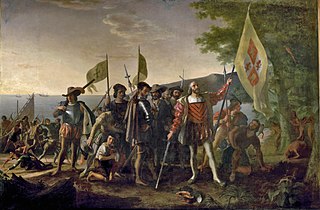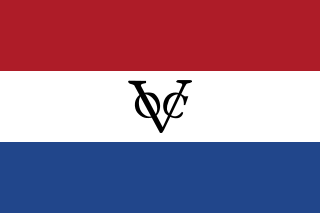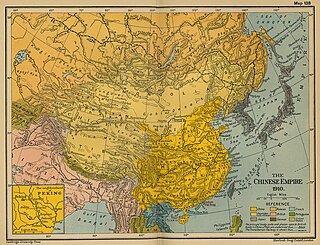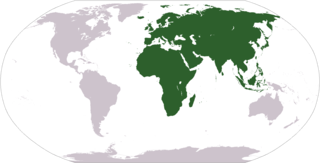 W
WWestern imperialism in Asia involves the influence of people from Western Europe and associated states in Asian territories and waters. Much of this process stemmed from the 15th-century search for trade routes to China that led directly to the Age of Discovery, and the introduction of early modern warfare into what Europeans first called the East Indies and later the Far East. By the early 16th century, the Age of Sail greatly expanded Western European influence and development of the spice trade under colonialism. European-style colonial empires and imperialism operated in Asia throughout six centuries of colonialism, formally ending with the independence of the Portuguese Empire's last colony East Timor in 2002. The empires introduced Western concepts of nation and the multinational state. This article attempts to outline the consequent development of the Western concept of the nation state.
 W
WThe Age of Discovery, or the Age of Exploration, is an informal and loosely defined term for the period in European history in which extensive overseas exploration, led by the Portuguese, emerged as a powerful factor in European culture, most notably the European rediscovery of the Americas. It also marks an increased adoption of colonialism as a national policy in Europe. Several lands previously unknown to Europeans were discovered by them during this period, though most were already inhabited.
 W
WAmbon was a governorate of the Dutch East India Company, consisting of Ambon Island and ten neighbouring islands. Steven van der Hagen captured Fort Victoria on 22 February 1605 from the Portuguese in the name of the Dutch East India Company. Until 1619, Ambon served as the capital of the Dutch possessions in East Asia. In that year Batavia was founded to function as the staple port for the Dutch East India Company in Asia. The island was the world center of clove production until the 19th century. The Dutch prohibited the rearing of the clove-tree in all the other islands subject to their rule, in order to secure the monopoly to Ambon.
 W
WFrom the 17th century through to the 19th century, the Habsburg Monarchy, Austrian Empire, and Austro-Hungarian Empire made a few small short-lived attempts to expand colonial trade through the acquisition of factories. All attempts were ended due to international pressure, or lack of interest from the Imperial government and opposition from Hungarians high in the government.
 W
WThe Austrian colonization of the Nicobar Islands involved a series of three separate attempts to colonize and settle the Nicobar Islands by the Habsburg Monarchy, and later the Austrian Empire. During the period of Austrian colonization, the Nicobar Islands were previously colonized by the Danish in 1756, but were abandoned due to multiple outbreaks of malaria. The Danes though still laid formal claim to the islands. The first attempt was the only time where the island chain was successfully colonized by the Austrians. The second attempt was canceled; and the third attempt, in 1886, was abandoned due to prior colonization by the British in 1868.
 W
WThe Banda Islands were a governorate of the Dutch East India Company. The governorate comprised Banda Neira, Banda Besar, Pulau Ai, Run, Banda Api, and some smaller islands.
 W
WBengal was a directorate of the Dutch East India Company in Mughal Bengal between 1610 until the company's liquidation in 1800. It then became a colony of the Kingdom of the Netherlands until 1825, when it was relinquished to the British according to the Anglo-Dutch Treaty of 1824. Dutch presence in the region started by the establishment of a trading post at Pipili in the mouth of Subarnarekha river in Odisha. The former colony is part of what is today called Dutch India. 50% of textiles and 80% of silks were imported from Bengal to the Dutch Empire.
 W
WDutch Celebes refers to the period of colonial governance on the island of Sulawesi - as a commandment of the Dutch East India Company from 1699 until its demise in the early 1800s, and then as a part of the Netherlands Indies or Dutch East Indies until 1945. Dutch presence in the region started with the capture of Sulawesi from the Portuguese, and ended by the declaration of independence by Indonesia. Celebes is now referred to as Sulawesi. Makassar, the capital, was also referred to as: Macassar, Makassar, Macaçar, Mancaçar, or Goa, Gowa.
 W
WConcessions in China were a group of concessions that existed during the late Imperial China and the Republic of China, which were governed and occupied by foreign powers, and are frequently associated with colonialism.
 W
WColonial India was the part of the Indian subcontinent that was under the jurisdiction of European colonial powers during the Age of Discovery. European power was exerted both by conquest and trade, especially in spices. The search for the wealth and prosperity of India led to the colonization of the Americas by Christopher Columbus in 1492. Only a few years later, near the end of the 15th century, Portuguese sailor Vasco da Gama became the first European to re-establish direct trade links with India since Roman times by being the first to arrive by circumnavigating Africa. Having arrived in Calicut, which by then was one of the major trading ports of the eastern world, he obtained permission to trade in the city from Saamoothiri Rajah. The next to arrive were the Dutch, with their main base in Ceylon. Their expansion into India was halted, after their defeat in the Battle of Colachel by the Kingdom of Travancore, during the Travancore-Dutch War.
 W
WCoromandel was a governorate of the Dutch East India Company on the Coromandel Coast between 1610 until the company's liquidation in 1798. Dutch presence in the region began with the capture of Pulicat from the Portuguese, which then became a colony of the Kingdom of the Netherlands until 1825, when it was relinquished to the British according to the Anglo-Dutch Treaty of 1824. It is part of what is today called Dutch India.
 W
WDutch India consisted of the settlements and trading posts of the Dutch East India Company on the Indian subcontinent. It is only used as a geographical definition, as there has never been a political authority ruling all Dutch India. Instead, Dutch India was divided into the governorates Dutch Ceylon and Dutch Coromandel, the commandment Dutch Malabar, and the directorates Dutch Bengal and Dutch Suratte.
 W
WDutch Malabar, also known by the name of its main settlement Cochin, was the title of a commandment of the Dutch East India Company on the Malabar Coast between 1661 and 1795, and is part of what is today collectively referred to as Dutch India. Dutch presence in the region started with the capture of Portuguese Quilon, and ended with the occupation of Malabar by the British in 1795. They possessed military outposts in 11 locations: Alleppey, Ayacotta, Chendamangalam, Pappinivattom, Ponnani, Pallipuram, Cranganore, Chetwai, Cannanore, Cochin, and Quilon.
 W
WThe East Indies or the Indies are the lands of South Asia and Southeast Asia. In a more restricted sense, the Indies can be used to refer to the islands of Southeast Asia, especially the Philippine Archipelago and the Indonesian Archipelago. The name "Indies" is used to connote parts of Asia that came under the Indian cultural sphere.
 W
WThe European influence in Afghanistan refers to political, social, and mostly imperialistic influence several European nations and colonial powers have had on the historical development of Afghanistan.
 W
WIn the Philippines, Filipino mestizo or colloquially tisoy, are people of mixed Filipino and any foreign ancestry. The word mestizo itself is of Spanish origin; it was first used in the Americas to describe only people of mixed Native American and European ancestry.
 W
WThe first European colonization wave began with Castilian Conquest of the Canary Islands, and primarily involved the European colonization of the Americas, though it also included the establishment of European colonies in India and in Maritime Southeast Asia. During this period, European interests in Africa primarily focused on the establishment of trading posts there, particularly for the African slave trade. The wave ended with British annexation of Kingdom of Kandy in 1815 and founding of colony of Singapore in 1819.
 W
WThe island of Taiwan, also commonly known as Formosa, was partly under colonial rule by the Dutch Republic from 1624 to 1662. In the context of the Age of Discovery, the Dutch East India Company established its presence on Formosa to trade with the Ming Empire in China and Tokugawa shogunate in Japan, and also to interdict Portuguese and Spanish trade and colonial activities in East Asia.
 W
WMacau is a Special Administrative Region (SAR) of the People's Republic of China. In 1557 it was leased to Portugal as a trading post in exchange for an annual rent of 500 tael in order to stay in Macau, it remained under Chinese sovereignty and authority until 1887, the Portuguese came to consider and administer it as a de facto colony. Following the signing of the Treaty of Nanking between China and Britain in 1842, and the signing of treaties between China and foreign powers during the 1860s, establishing the benefit of "the most favoured nation" for them, the Portuguese attempted to conclude a similar treaty in 1862, but the Chinese refused, owing to a misunderstanding over the sovereignty of Macau. In 1887 the Portuguese finally managed to secure an agreement from China that Macao was Portuguese territory. In 1999 it was handed over to China. Macau was the last extant European territory in continental Asia.
 W
WManama is the capital and largest city of Bahrain, with an approximate population of 157,000 people. Long an important trading center in the Persian Gulf, Manama is home to a very diverse population. After periods of Portuguese and Persian control and invasions from the ruling dynasties of Saudi Arabia and Oman, Bahrain established itself as an independent nation in 1971 after a period of British hegemony.
 W
WThe term "Old World" is used commonly in the West to refer to Africa, Asia and Europe, regarded collectively as the part of the world known to its population before contact with the "New World".
 W
WThe Shanghai French Concession was a foreign concession in Shanghai, China from 1849 until 1943, which progressively expanded in the late 19th and early 20th centuries. The concession came to an end in 1943 when the French State under German pressure signed it over to the pro-Japanese Reorganized National Government of China in Nanjing. For much of the 20th century, the area covered by the former French Concession remained the premier residential and retail district of Shanghai, and was also one of the centres of Catholicism in China. Despite re-development over the last few decades, the area retains a distinct character and is a popular tourist destination.
 W
WThe Shanghai International Settlement originated from the merger in the year 1863 of the British and American enclaves in Shanghai, in which British subjects and American citizens would enjoy extraterritorially and consular jurisdiction under the terms of Unequal Treaties signed in the nineteenth century with the Qing Dynasty. These treaties were abrogated in 1943 by agreement with the Kuomintang, then based in Chungking.
 W
WThe Spanish East Indies were the overseas territories of the Spanish Empire in Asia and Oceania from 1565 to 1901 governed from Manila in the Spanish Philippines. The seat of government was in the Spanish Philippines and it encompassed the Marianas, Carolines, Palaos and Guam, as well as parts of Formosa (Taiwan), Sulawesi (Celebes) and the Moluccas (Maluku). The King of Spain traditionally styled himself "King of the East and West Indies".
 W
WThe Stranger King theory offers a framework to understand global colonialism. It seeks to explain the apparent ease whereby many indigenous peoples subjugated themselves to an alien colonial power and places state formation by colonial powers within the continuum of earlier, similar but indigenous processes.
 W
WThe concessions in Tianjin were concession territories ceded by the Chinese Qing dynasty to a number of European countries, the U.S. and Japan within the city of Tianjin. There were nine concessions in old Tianjin altogether. These concessions also contributed to the rapid development of Tianjin from the early to mid-20th century. The first concessions in Tianjin were granted in 1860. By 1943, all the foreign concessions, save the Japanese concession, had ceased to exist de facto.